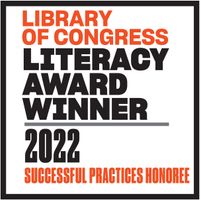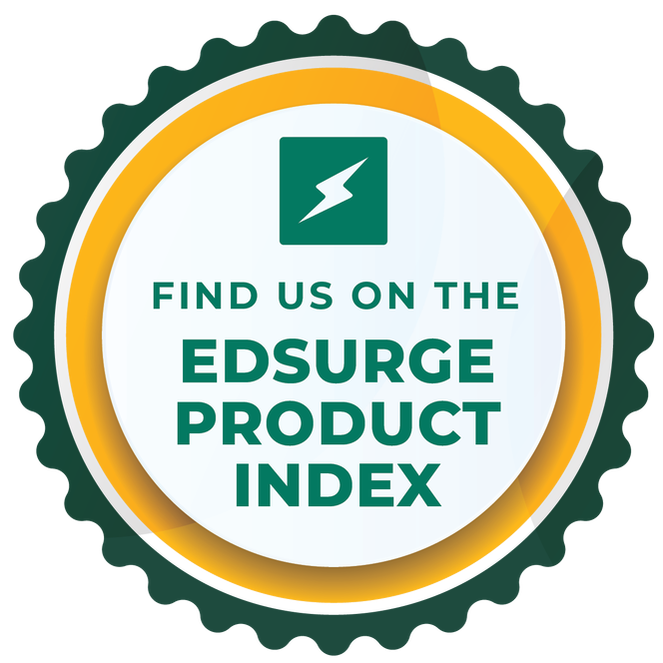ReadWorks is different. Research is at our core.
As teachers face the critical challenge of helping students become successful, joyful readers, they need resources that they know will work. However, “there is a stunning lack of research and evidence to support the efficacy of” the 11K+ edtech tools available (source). Read our research blog!
More than a decade of research:

"Article-A-Day + Decodables Descriptive Efficacy Study in the DC Metro Area" (2024), Intervention study
"The Impact of Article-A-Day Passages on Students' Vocabulary and Background Knowledge on Animals" (2023), Intervention study
"Using Article-A-Day as a Regular Part of Instruction" (2022), Case study
"Article-A-Day for Multiple Grades at an Elementary School in Trinidad and Tobago" (2022), Case study
"Implementing Article-A-Day" (2020), Intervention study
"Picture Placement: Testing the Impact of Picture Placement on Reading Comprehension" (2018), NYU BetaEd
"Summary of English Language Arts Outcomes at Elementary Schools Implementing ReadWorks" (2016), Rockman et al
- In a 6-week pilot with 12 students of color, including 4 English language learners and 3 students with dyslexia, students increased an average of 37% (median 38.5%) on their pseudo/nonsense word fluency, exceeding their expected growth goals.
- Teachers reported an increased understanding of how to build early readers’ background knowledge while supporting their word recognition skills, as well as the value of doing so.
Download the full report now!
"The Impact of Article-A-Day Passages on Students' Vocabulary and Background Knowledge on Animals" (2023), Intervention study
- In a 6-week pilot with 8 teachers across 13 classrooms, there was an emerging trend that the experimental group improved to a greater extent than the control group on both the background knowledge and vocabulary measures, which would indicate the impact of Article-A-Day passages on improving students’ knowledge on the topic of animals.
- There is no best (or worst) format for all readers.
- Personalized formats significantly improve reading comprehension for both word- and passage-level reading.
"Using Article-A-Day as a Regular Part of Instruction" (2022), Case study
- In an exploratory case study of the impact of Article-A-Day to support unfinished learning due to COVID-19, we observed that student engagement increased in the virtual classroom setting, and students’ reading and writing production increased.
- Overall, students' monthly standardized testing scores improved, a correlational effect the teacher and school attributed to regular Article-A-Day implementation.
- Students’ multiple-choice questions correct rate increases up to 5% as their experience with the assignments gets longer. That is, students progress over time, implying that students benefit from regularly doing ReadWorks question sets.
- Corroborating the 2020 and 2019 Digital Promise studies (see below), differentiation is positively associated with various student involvement and performance measures such as assignment open rate and response correct rate. The impact of differentiation on student assignment open rate is even larger for the high-poverty group than that for the low-poverty group, implying the potential benefits of differentiation, especially for more disadvantaged groups.
- Students are spending even more time on below grade-level work than they were before the pandemic.
- Students in schools serving more students experiencing poverty were assigned the most below grade-level work.
- In schools serving more students in poverty, students got less access to grade-level work even when they’d already shown they can master it.
- Corroborating the 2020 NYU Marron Institute study (see below), the COVID pandemic has negatively affected high- and low-poverty groups in terms of assignment open rate. The magnitude of negative impact is larger for the high-poverty group.
- For students who opened assignments before and after the COVID pandemic, their performances on structured assignments (multiple choice questions) increased while their performances on unstructured (open-ended writing) assignments decreased, implying that students need more structure in virtual learning.
"Article-A-Day for Multiple Grades at an Elementary School in Trinidad and Tobago" (2022), Case study
- In an exploratory case study of the impact of a whole-school implementation of Article-A-Day as an enrichment activity, we observed growth in background knowledge and vocabulary and engagement around learning in the individual students and across the school community as a whole, including families.
- In an 8-week pilot study, students who did the Meaning Mapper activity for multiple weeks often made their own connections among words in their written responses and reported an increased vocabulary understanding.
- Specifically, students made frequent connections between ReadWorks-chosen vocabulary words and new words of their choosing and between words from earlier connections and new words of their choosing.
- Greater use of ReadWorks was positively related to increased growth in students’ standardized reading test scores, suggesting that the platform is generally efficacious in supporting students’ reading comprehension.
- Students showed greater engagement with harder assignments when using support features, such as audio, text magnification, and annotation, that allow them to personalize for their needs.
- A student’s teacher is a significant predictor of students’ support feature use. These results indicate that professional development for teachers that specifically encourages understanding and use of support features is needed.
"Implementing Article-A-Day" (2020), Intervention study
- In a 4-week pilot in 2 schools, students who did Article-A-Day for 4-5 days each week increased both the length of their written responses and their use of Tier 2 and 3 vocabulary.
- The impact of the COVID pandemic on students opening digital assignments was uneven, with losses disproportionately concentrated among students in high-poverty schools.
- Looking at high-poverty schools (defined as schools where 75%+ of students qualify for the National School Lunch Program), 15 states had at least a 30% reduction in students opening assignments.
"Picture Placement: Testing the Impact of Picture Placement on Reading Comprehension" (2018), NYU BetaEd
- Students were more likely to complete the reading assignment and scored higher when the image was at the beginning of the text, with effects diminishing with grade level.
"Summary of English Language Arts Outcomes at Elementary Schools Implementing ReadWorks" (2016), Rockman et al
- In a pilot with 9 schools, students who routinely did Article-A-Day showed a 4.7% year-over-year gain in ELA test scores compared to the NYC average of 1.4% and 1.1% for economically disadvantaged schools.
- More specifically, 8 of the 9 schools showed a higher rate of improvement than the NYC average and the NYC average for economically disadvantaged schools.
Foundational Studies in Reading Comprehension
READING COMPREHENSION: SEMINAL FINDINGS AND RESEARCH
August, D., & Shanahan, T. (2006). Developing literacy in second-language learners: Report of the national literacy panel on language minority children and youth. Mahwah, NJ: Lawrence Erlbaum Associates.
Hebbecker, K., Förster, N., & Souvignier, E. (2019). Reciprocal effects between reading achievement and intrinsic and extrinsic reading motivation. Scientific Studies of Reading, 23(5), 419-436.
Kamil, M. L., Borman, G. D., Dole, J., Kral, C. C., Salinger, T., & Torgesen, J. (2008). Improving adolescent literacy: Effective classroom and intervention practices: A practice guide (NCEE #2008-4027). Washington, DC: National Center for Education Evaluation and Regional Assistance, Institute of Education Sciences, U.S. Department of Education.
National Institute of Child Health and Human Development (2000). Report of the National Reading Panel: Teaching Children to Read. An evidence-based assessment of the scientific research literature on reading and its implications for reading instruction (NIH Publication No.00-4769). Washington, DC: U.S. Government Printing Office.
Pearson, P. D., & Gallagher, M. C. (1983). The instruction of reading comprehension. Contemporary Educational Psychology, 8(3), 317-344.
Pearson, P. D., Palincsar, A. S., Biancarosa, G., & Berman, A. I. (2020). Reaping the rewards of the Reading for Understanding initiative. Washington, DC: National Academy of Education.
Snow, C. (2002). Reading for understanding: Towards an R&D program in reading comprehension. RAND Reading Study Group.
Hebbecker, K., Förster, N., & Souvignier, E. (2019). Reciprocal effects between reading achievement and intrinsic and extrinsic reading motivation. Scientific Studies of Reading, 23(5), 419-436.
Kamil, M. L., Borman, G. D., Dole, J., Kral, C. C., Salinger, T., & Torgesen, J. (2008). Improving adolescent literacy: Effective classroom and intervention practices: A practice guide (NCEE #2008-4027). Washington, DC: National Center for Education Evaluation and Regional Assistance, Institute of Education Sciences, U.S. Department of Education.
National Institute of Child Health and Human Development (2000). Report of the National Reading Panel: Teaching Children to Read. An evidence-based assessment of the scientific research literature on reading and its implications for reading instruction (NIH Publication No.00-4769). Washington, DC: U.S. Government Printing Office.
Pearson, P. D., & Gallagher, M. C. (1983). The instruction of reading comprehension. Contemporary Educational Psychology, 8(3), 317-344.
Pearson, P. D., Palincsar, A. S., Biancarosa, G., & Berman, A. I. (2020). Reaping the rewards of the Reading for Understanding initiative. Washington, DC: National Academy of Education.
Snow, C. (2002). Reading for understanding: Towards an R&D program in reading comprehension. RAND Reading Study Group.
BACKGROUND KNOWLEDGE
Anderson, R. C., & Pearson, P. D. (1984). A schema-theoretic view of basic processes in reading comprehension. Handbook of Reading Research, 1, 255-291.
Cabell, S. Q., & Hwang, H. (2020). Building content knowledge to boost comprehension in the primary grades. Reading Research Quarterly, 55, S99-S107.
Cervetti, G. N., & Hiebert, E. H. (2019). Knowledge at the center of English language arts instruction. The Reading Teacher, 72(4), 499-507.
Cervetti, G. N., & Hiebert, E. H. (2015). The sixth pillar of reading instruction: Knowledge development. The Reading Teacher, 68(7), 548-551.
Hirsch, E. D. (2003). Reading comprehension requires knowledge - of words and the world: Scientific insights into the fourth-grade slump and stagnant reading comprehension. American Educator, 27(1), 10-22.
Marzano, R. J. (2004). Building background knowledge for academic achievement. ACSD: Alexandria, VA.
Pearson, P. D., Hansen, J., & Gordon, C. (1979). The effect of background knowledge on young children's comprehension of explicit and implicit information. Journal of Reading Behavior, 11(3), 201-209.
Recht, D. R., & Leslie, L. (1988). Effect of prior knowledge on good and poor readers' memory of text. Journal of Educational Psychology, 80(1), 16-20.
Cabell, S. Q., & Hwang, H. (2020). Building content knowledge to boost comprehension in the primary grades. Reading Research Quarterly, 55, S99-S107.
Cervetti, G. N., & Hiebert, E. H. (2019). Knowledge at the center of English language arts instruction. The Reading Teacher, 72(4), 499-507.
Cervetti, G. N., & Hiebert, E. H. (2015). The sixth pillar of reading instruction: Knowledge development. The Reading Teacher, 68(7), 548-551.
Hirsch, E. D. (2003). Reading comprehension requires knowledge - of words and the world: Scientific insights into the fourth-grade slump and stagnant reading comprehension. American Educator, 27(1), 10-22.
Marzano, R. J. (2004). Building background knowledge for academic achievement. ACSD: Alexandria, VA.
Pearson, P. D., Hansen, J., & Gordon, C. (1979). The effect of background knowledge on young children's comprehension of explicit and implicit information. Journal of Reading Behavior, 11(3), 201-209.
Recht, D. R., & Leslie, L. (1988). Effect of prior knowledge on good and poor readers' memory of text. Journal of Educational Psychology, 80(1), 16-20.
VOCABULARY
Beck, I., McKeown, M., & Kucan, L. (2013). Bringing words to life: Robust vocabulary instruction (2nd ed.). New York, NY: The Guilford Press.
Beech, J.R. (2001). What happens when an unfamiliar word is encountered while reading? A metacognitive study of the strategies reported by 7- to 11-year olds. Paper presented at the 5th International Conference of the British Dyslexia Association.
Cervetti, G. N., Wright, T. S., & Hwang, H. (2016). Conceptual coherence, comprehension, and vocabulary acquisition: A knowledge effect?. Reading and Writing, 29(4), 761-779.
Gillis, M.B., & Eberhardt, N.C. (2018). Literacy how professional learning series (Syntax; Vocabulary; Comprehension). Available at Amazon.com.
Graves, M. F. (2016). The vocabulary book: Learning and instruction. Teachers College Press.
Hiebert, E. H. (2019). Teaching words and how they work: Small changes for big vocabulary results. Teachers College Press.
Kaefer, T., Neuman, S. B., & Pinkham, A. M. (2015). Pre-existing background knowledge influences socioeconomic differences in preschoolers’ word learning and comprehension. Reading Psychology, 36(3), 203-231.
Neuman, S. B., & Dwyer, J. (2011). Developing vocabulary and conceptual knowledge for low-income preschoolers: A design experiment. Journal of Literacy Research, 43, 103–129.
Wright, T. S., & Neuman, S. B. (2014). Paucity and disparity in kindergarten oral vocabulary instruction. Journal of Literacy Research, 46(3), 330-357.
Beech, J.R. (2001). What happens when an unfamiliar word is encountered while reading? A metacognitive study of the strategies reported by 7- to 11-year olds. Paper presented at the 5th International Conference of the British Dyslexia Association.
Cervetti, G. N., Wright, T. S., & Hwang, H. (2016). Conceptual coherence, comprehension, and vocabulary acquisition: A knowledge effect?. Reading and Writing, 29(4), 761-779.
Gillis, M.B., & Eberhardt, N.C. (2018). Literacy how professional learning series (Syntax; Vocabulary; Comprehension). Available at Amazon.com.
Graves, M. F. (2016). The vocabulary book: Learning and instruction. Teachers College Press.
Hiebert, E. H. (2019). Teaching words and how they work: Small changes for big vocabulary results. Teachers College Press.
Kaefer, T., Neuman, S. B., & Pinkham, A. M. (2015). Pre-existing background knowledge influences socioeconomic differences in preschoolers’ word learning and comprehension. Reading Psychology, 36(3), 203-231.
Neuman, S. B., & Dwyer, J. (2011). Developing vocabulary and conceptual knowledge for low-income preschoolers: A design experiment. Journal of Literacy Research, 43, 103–129.
Wright, T. S., & Neuman, S. B. (2014). Paucity and disparity in kindergarten oral vocabulary instruction. Journal of Literacy Research, 46(3), 330-357.
OTHER CRITICAL FACTORS: TEXT STRUCTURE AND SYNTAX
Graesser, A. C., Millis, K., & Long, D. L. (1986). The construction of knowledge structures and inferences during text comprehension. Advances in Cognitive Science, 1, 125-157.
Idol, L. (1987). Group story mapping: A comprehension strategy for both skilled and unskilled readers. Journal of Learning Disabilities, 20(4), 196-205.
Williams, J. P., Hall, K. M., & Lauer, K. D. (2004). Teaching expository text structure to young at-risk learners: Building the basics of comprehension instruction. Exceptionality, 12(3), 129-144.
Williams, J. P., Hall, K. M., Lauer, K. D., Stafford, K. B., DeSisto, L. A., & deCani, J. S. (2005). Expository text comprehension in the primary grade classroom. Journal of Educational Psychology, 97(4), 538-550.
Idol, L. (1987). Group story mapping: A comprehension strategy for both skilled and unskilled readers. Journal of Learning Disabilities, 20(4), 196-205.
Williams, J. P., Hall, K. M., & Lauer, K. D. (2004). Teaching expository text structure to young at-risk learners: Building the basics of comprehension instruction. Exceptionality, 12(3), 129-144.
Williams, J. P., Hall, K. M., Lauer, K. D., Stafford, K. B., DeSisto, L. A., & deCani, J. S. (2005). Expository text comprehension in the primary grade classroom. Journal of Educational Psychology, 97(4), 538-550.
Thank you for the wisdom, encouragement, and dedication of our partner schools, districts,
and academic research advisors.
and academic research advisors.















